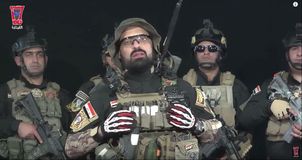As in other countries, music in Iraq has long been in service of the state. The sounds of these state-sanctioned anthems reverberate well beyond the historic events they attested to.
Music is the carving knife state’s employ for moulding public attitudes that lean favourably towards its actions and beliefs. Production is typically high in times of war, whether in the context of the fight against the Islamic State (IS) or the 8 year long Iraq-Iran war and others fought under the pre-2003 Iraqi government.
The invasion of American troops 14 years ago, offset new musical genres in Iraq. Exactly 24 hours after US and British tanks rolled into the country, insurgency and militias rapidly formed, and musical productions were part and parcel of their rallying efforts. As the quest for power and resistance against occupant forces began, as did the search for heroic anthems, some new, others recycled chart-toppers from Iraq’s recent past.
A new musical trend has slowly crept into the public sphere. Its emergence coincides with the conquest of Mosul by IS terrorists. These new songs and sounds are in fact endorsed from above, taking inspiration from the government's latest war, depicted lyrically and visually, and the long awaited annihilation of terrorist formations.
This musical trend — a blend of popular sounds, tribal folklore, and flagrant propaganda — speaks more to the mood of state forces and accompanying militias than the mood of the people.
While much interest has been spilt over the Nasheed anthems IS produces, these state funded songs eulogizing foreign-backed forces and volunteers, are taken little notice of in the western social media sphere.
Uniformed militias, brandishing heavy weaponry as they spin on their heel in traditional Iraqi fashion — are hallmarks of the new trend.
As important as the inclusion of traditional sounds is imagery, to maintain appeal.
Scenes of heroism, violence in battle and glamorised guerilla warfare is how these songs derive their seductive power. More importantly, the newest anti-IS inspired genre is distinguishable from patriotic songs of the past by its sectarian language and associated motifs.
This may not be apparent to all listeners.
The highly localised and colloquial dialects of this music renders songs near incomprehensible to non-Iraqis, even if listeners are kept bopping. To bridge the gap, online users have made translations of some songs available.
What also tends to pass non-Iraqi audiences by is the cheapness these sounds and their flashy productions exude. Espousal of thuggery, violence and hate fuelled revenge make these songs unpopular with a large sector of the local audience.
The lyrical content speaks to exclusively to male listeners, propagating not only political messages but also conceptions of manly valor and fortitude. These conceptions inform the messages the songs transmit, serving audiences a generous helping of national pride. The sectarian foundations of this musically expressed ‘national pride’ mocks arguments in which the songs propaganda content is downplayed.
A similar irony reveals itself in songs produced by Lebanon’s Hezbollah for factions of Iraq’s Popular Mobilization Forces (PMF), featuring Iraqi singers donning military uniforms. The words sung fit largely within in Shi’i repertoire in reinforcement of the political Islamic identity of Iraqi forces, and praise of the Tehran-backed commanders that guide them. The language of sectarianism mirrors the government’s approach to politics, instead of addressing Iraq as a collective society.
That’s one view, another comes in the form of a caution to not confuse oratory propaganda for grassroots music.
“One might wonder if these songs were part of a propaganda to encourage young men … However the essence might rest in the age of social media, since these men did not really need propaganda to build enthusiasm” -- is one contextually devoid argument published on ezine, Jadaliyya.
Away from assumptions about what roused droves of men to bear arms, it is important to unpack the political motivations driving these new productions.
The risqué video received mixed reactions, whose progressive protagonist was cheered on by English speaking audiences, but dismissed by some local audiences as dishonourable. Some called the song a ‘music revolution’ others described it a pro-Kurdish independence anthem. “My weapon is my music” Luv said in a Fox News interview, seeing the heinous litany of rights IS perpetrated “enlighted [sic] a fire inside of me” she told the female anchor.
Whether they are Arabic or Kurdish productions, both sharpen perceptions manufactured at state level, and therefore lend themselves to the discourse that Iraq’s war on terror is a tale of success.
Our war is just and moral, a battle fought til the bitter end, listeners are told.
For the political actors concerned, the demoralising defeat of IS is important to replicate beyond the frontlines, which has transformed the realm of popular music into the latest battle ground. Excluded from this soundscape however are the voices silenced in this conflict, the communities liberated by the gun, who receive barely a whisper.
The rhetoric of battle such songs promote, favours half cooked truths and hollywood-inspired tales of victory, bravery and camaraderie. The tools used to achieve this are made available by composers, poets, bards, Rowadeed (reciters of religious verse) coopted by the state to promote their linear account of history.
This is similar to the ‘Jingoist’ movement in late 1800s UK. In the midst of the war with Russia, propagandists spread highly charged, nationalistic and aggressively worded songs with political slogans across Britain. This helped create support and consensus among the British public that they were fighting a just war.
Almost a century on, music is still used to monopolise political discourse.
The new pop-culture trend may perforate the hearts and minds of some Iraqis, but the reality suggests the music is not as emancipatory as audiences are led to think.






 RSS Feed
RSS Feed